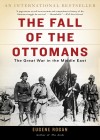The Fall of the Ottomans: The Great War in the Middle East
Written by: Eugene Rogan,
Basic Books, New York, 2015,
ISBN: 9780465023073, 485pp
Reviewed by: Dr William Westerman
With much of the attention of the First World War focused on the Western Front (both when it was being waged and ever since), it is a welcome change to explore a different theatre of that immense conflict. To the Entente powers, the war in the Middle East served simply to divert both their attention and, importantly, their resources, but to the Ottoman Empire it was fundamentally about survival. From 1914 to 1918 they defended their empire against multiple invasions and uprisings; by the end of the war, however, the perpetually ‘sick man of Europe’ had finally succumbed to his affliction.
Eugene Rogan’s The Fall of the Ottomans: The Great War in the Middle East tells this story and in so doing enhances the modern understanding of the global dimensions of the First World War. Setting the stage early with the rise of the Young Turks and the prelude of wars fought prior to 1914, Rogan covers the war in the Middle East with a sweeping scope, following the various campaigns fought on and within the over 7500 miles of borders and coastlines the Ottoman Army was required to defend, culminating with defeat in 1918 and dissolution of the empire in the post-war period. The large narrative that Rogan crafts gives the reader a sense of just how vast and at times complex this part of the First World War really was.
To Australia, the most familiar event in this theatre was the 1915 Gallipoli campaign. Rogan enlivens this well-worn story by placing it in a wider perspective. He observes that the decision to force the Dardanelles and then to invade Gallipoli occurred against the backdrop of Russian success at Sarikamis, the British capture and defence of Basra and the successful defence of the Suez Canal (all of which played out between December 1914 and April 1915). These Ottoman defeats created a poor impression of the Ottoman Army and gave British and French war planners optimism that a decisive blow against the empire could be struck through the Dardanelles.
Other familiar stories, such as the actions of enigmatic British officer Captain T.E. Lawrence, are discussed and given the appropriate contextual background (Rogan appears careful not to give too much weight to the ‘Lawrence of Arabia’ narrative). The Fall of the Ottomans also covers events that may have languished in the collective memory of Australian readers, or those that exist in the veiled periphery of imperial memory, such as the Siege of Kut-al-Amara in late 1915 and early 1916, or the capture of Baghdad in 1917.
An enjoyable aspect of the book is Rogan’s highlighting of events and entire campaigns which are not often covered in Anglo-centric studies of the Middle East during the Great War, such as the Russian Army’s Caucasus campaigns (and particularly the very significant capture of Erzurum in early 1916), or the early stages of the Arab Revolt in the Hijaz in late 1916. These are reinforced by one of the strengths of The Fall of the Ottomans, namely the use of Ottoman and Arab sources, giving voice to a wide variety of those within the Ottoman Empire who are usually silent in Western histories.
The Fall of the Ottomans also touches on several issues that resonate a century later, such as the prospect of deliberately inciting jihad across the Muslim world against the European colonial powers. Likewise the book describes the shaping of the post-war Middle East through the Sykes-Picot Agreement, the Balfour Declaration, and the arrangement with Hashemite Arab leader Sharif Husayn for control over sections of the Ottoman Empire in return for taking up arms against them.
Rogan is not a military historian in the sense that he does not provide a detailed tactical analysis of how the war in the Middle East was fought; the canvas is simply too large and the time period too long to engage thoroughly with smaller details. This is a narrative that exists in the operational, strategic and geopolitical spheres, and therein lies its great advantage. In zooming out from Anzac Cove or Beersheba, the reader is shown a wider story, and actions assume new context and new importance, highlighting the complexity of the conflict in which Australian soldiers were involved. In addition to providing a highly satisfying account of the First World War in the Middle East, The Fall of the Ottomans points an Australian reader to the realisation of just how peripheral the Australian involvement was for most of the war. For anyone who seeks to understand the wider context, this is an excellent resource.

